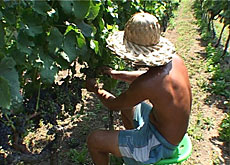Swiss vintners go in search of new palates

Switzerland’s wine producers have uncorked a new strategy to improve their reputation and boost sales at home and abroad.
In 2003, Switzerland exported 1.5 million litres of wine – a mere drop in the ocean alongside imports of more than 160 million litres.
“For our export activities we are trying to focus on a few markets that are important, namely Germany and the Benelux countries,” Jürg Bussmann, director of the Swiss Wine Association (SWA), told swissinfo.
“There is also a good link between Switzerland and Belgium and we have been very active there in the past,” he added.
But further afield, in Britain, for example, Swiss wines are still relatively unknown.
“If I had a pound for every time somebody said they didn’t know the Swiss made wine, I would earn a lot more money than by selling Swiss wine,” revealed Ian Steel of the British-based Swiss wine importer, “For the Love of Wine”.
According to Steel, around 30,000 bottles of Swiss wine were sold in Britain in 2003, compared with several million bottles of French wine.
“The main problem with Swiss wine is that there is very little cheap wine that is of a good quality. Therefore introducing people to Swiss wines is difficult,” he said.
For British consumers, this situation is likely to continue as the SWA’s campaign is aimed more at the middle and premium segments of the market.
“We have to focus on the middle part of the market and I believe, when it comes to tasting the wine, we are extremely competitive. The only problem is that very few people know that,” said Bussmann.
Free market
Since the liberalisation of Switzerland’s wine market in 1995, the Swiss have gradually consumed less of own vintage.
In 2003 they drank around 115 million litres of Swiss wine – 7.3 million litres less than the year before.
“Even though our market share is still 40 per cent, we have been facing heavy competition from other producers since the market was liberalised in the mid-nineties,” lamented Bussmann.
Overall, wine consumption in Switzerland has also dropped continuously over the past decade.
Whereas the Swiss drank more than 318 million litres of wine in 1990, they only enjoyed 285 million litres in 2003, according to SWA figures.
The figures also suggest that Swiss consumers are more into drinking a good glass of red wine rather than white.
In 2003 85 million litres of white wine were consumed in Switzerland, compared with almost 200 million litres of red wine.
Bussmann dismissed suggestions that white wine consumption suffered because of the occasional use of screw tops rather than corks.
“Screw-top protected wines, which are mainly white, are consumed within two years and I think that’s ideal. It would be stupid to use cork, which is a natural resource, for something that is not needed,” Bussmann said.
“You won’t find the screw tops in the premium segment of the market. We will certainly continue to use the traditional style on those wine bottles.”
swissinfo, Billi Bierling
There are more than 22,000 winegrowers in Switzerland.
Switzerland’s most important wine growing regions in terms of volume are canton Valais, Vaud, Geneva and Ticino.
Switzerland produces roughly 4% of Europe’s wine, and just under 1% of the world’s wine.
Germany is Switzerland’s most important export country, followed by Belgium, France and Japan.
The most popular Swiss wine for export is Fendant white wine, produced predominantly in canton Valais. The Müller-Thurgau and Sylvaner are also important varieties.

In compliance with the JTI standards
More: SWI swissinfo.ch certified by the Journalism Trust Initiative












You can find an overview of ongoing debates with our journalists here . Please join us!
If you want to start a conversation about a topic raised in this article or want to report factual errors, email us at english@swissinfo.ch.